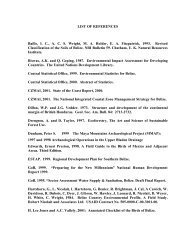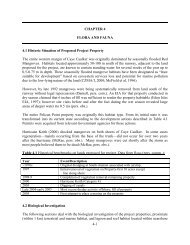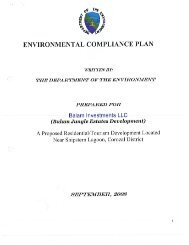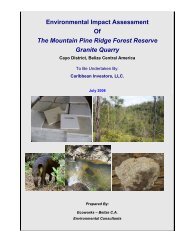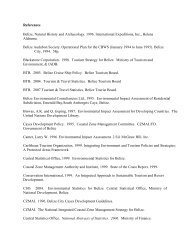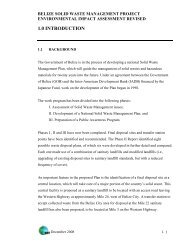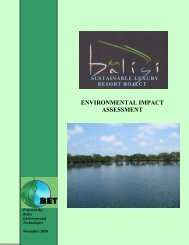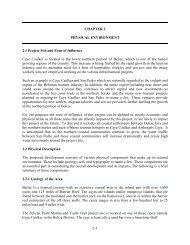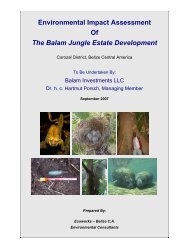Ambergris Caye Belize Resort Development - Department of ...
Ambergris Caye Belize Resort Development - Department of ...
Ambergris Caye Belize Resort Development - Department of ...
Create successful ePaper yourself
Turn your PDF publications into a flip-book with our unique Google optimized e-Paper software.
are associated with the rising and falling tides in the area: These currents are functionally nonexistent<br />
and at their weakest during ‘slack’ tide when the tides are changing from low tide to<br />
high tides and vice versa, and during the times immediately approaching ‘slack tide’ as well as in<br />
the aftermath <strong>of</strong> same [Pers. comm.., G. Myvett].<br />
2.2.8 Total Coliform and E. coli<br />
Total coliform as documented by the Tunich Nah Survey team ranged from 72/100 ml to<br />
142/100 ml. [See Table 2.1]. The E. coli counts for the samples taken were 0/100 ml [See Table<br />
2.1]. The latter means that the sea in front <strong>of</strong> the property has no discernible levels <strong>of</strong> pollution<br />
from human waste and the water is safe for swimming, snorkeling, scuba diving and other seabased<br />
recreational activities.<br />
The total coliform count recorded for the area would in effect be derived from warm blooded<br />
creatures such as marine mammals, vis-à-vis dolphins and manatees, as well as sea birds such as<br />
gulls and cormorants [Pers. comm.., G. Myvett].<br />
2.3 Biological Oceanography<br />
The location <strong>of</strong> the proposed project site in north-eastern <strong>Ambergris</strong> <strong>Caye</strong> is reflective <strong>of</strong> a<br />
diverse aggregation <strong>of</strong> species and ecosystems. Both the flora and faunal forms entails supratidal<br />
terrestrial forms, as well as sub-tidal components. The flora and faunal forms also varies in<br />
terms <strong>of</strong> the complexity <strong>of</strong> biological organization as well as in relation to their evolutionary<br />
history, abundance and distribution.<br />
2.3.1 Flora and Fauna<br />
The sub-tidal floral forms documented in the area varied from simpler macro-algal forms such as<br />
the Feather Algae (Caulerpa spp.) and the Shaving Bush Algae (Penicillus capitatus), to<br />
flowering forms such as the Turtle Grass (Thallasia testudinium) and Halodule (Halodule<br />
beaudettel) [See Table 2.2 B].<br />
The supratidal dune and terrestrial vegetation have been collectively classified as a ‘littoral<br />
forest’ [Meerman and Sabido, 2000]. This is one <strong>of</strong> seven (7) forest types identified by<br />
Grimshaw and Paz [2004] for the larger Bacalar Chico area. Tree species on the property were a<br />
reflection <strong>of</strong> the diversity <strong>of</strong> soil chemistry and landform, and ranged from typical beach<br />
inhibants like the coconut (Cocos nocifera) and the Australian Pine (Casuarina equisetifolia), to<br />
salt tolerant species such as the Red Mangrove (Rhiziphora mangle) and the Black Mangrove<br />
(Avicennia germinans), as well as ubiquitous coastal species such as Gumbo Limbo (Bursera<br />
simaruba), the Buttonwood (Conocarpus erectus) and the Sea Grape (Coccolaba uvifera) [See<br />
Table 2.2A].<br />
The faunal forms <strong>of</strong> the proposed project area cover all <strong>of</strong> the five (5) phylogenetic classes <strong>of</strong><br />
vertebrates, as well as an even more diverse assemblage <strong>of</strong> invertebrates. The most diverse and<br />
abundant classes <strong>of</strong> vertebrates were the fishes and the birds [See Tables 2.4 and 2.7], and the<br />
2-9




